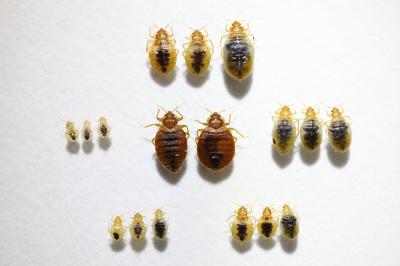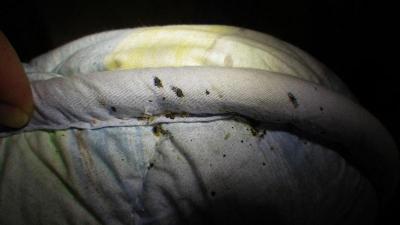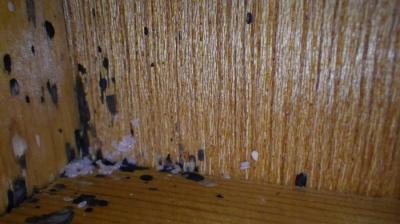- Yokohama-shi Top Page
- Living and Procedures
- Housing and Living
- Living Environment
- Public hygiene
- Pest
- About Tokouji Lami
Here's the text.
About Tokouji Lami
Last Updated August 4, 2021
In order to prevent damage to lice
The damage to Toko lice decreased since around the Tokyo Olympics (1964), and was rarely seen in the 1970s. However, it has been increasing gradually since around 2007, and recently consultations have increased in Yokohama City. The causes of the increase in damage were brought in by foreign visitors to Japan and returnees, and spread by moving goods.
For information about thorns, please refer to the leaflet "Beware of thorns! Don't bring it in! Don't increase it! (PDF: 4,833KB) "(updated in July 2021).
In addition, for information on measures against lice such as accommodation facilities, please refer to the leaflet "To prevent damage to lice-for business operators such as accommodation facilities-(PDF: 3,517KB)" (updated in July 2021) .
Toko lice (from larvae to adult)

The size of an adult is 5-8mm.
・It has no wings, is flat, oval and reddish brown.
・It produces brown droppings (blood droppings).
・There is a habit of lurking in narrow gaps.
・It works mainly at night (at bedtime).
Photo provided: Environmental Biology Department, Japan Environmental Center
Damage caused by lice
・Food is the blood of humans and animals, which mainly sucks blood at night (when sleeping), where the skin is exposed.
Itching is unlikely to occur immediately after blood is sucked, and repeated stabbing causes an allergic reaction and itching.
・It is very difficult to get rid of the increased lice, and it takes time and money, which increases the financial burden.
It is important to find it as soon as possible and take appropriate measures such as extermination.
The habitat of the toko lice
・Toko lice prefers narrow and dark places, and lurks in gaps during the daytime or when the room is bright.
<Hidden Place>
・The backs and gaps of tatami mats
・Curtain folds and seams
・Seams and gaps of mattresses on futons and pillows
・Furniture gaps, etc.
Blood feces (like black sesame), eggs, dead bodies, etc. can be found in places where lice lurks.
Seam of futon

The corner of the wall

Photo provided: Environmental Biology Department, Japan Environmental Center
To prevent the damage of lilies
Don't bring in thorns!
・When staying at a hotel (especially overseas), make sure that there are no rats and do not place luggage directly on the floor.
・Investigate the bags used for travel or business trips abroad and check for blood feces and molting shells.
Discover it early and get rid of it!
・Clean and organize the room on a daily basis, and be careful if there are any hidden places for lice.
How to get rid of rats
・Let's smoke with a vacuum cleaner and dispose of the trash immediately.
・Toko lice is sensitive to heat, so there is also a method using a steam cleaner (more than 10 minutes at 60°C).
・insecticide uses carbamates. When using it, follow the usage and dosage, and observe the progress if it is effective.
※Smoke agents (those that fill the room with smoke) run away to other places and spread, and rather spread the damage.
I don't recommend it because there is a risk.
※Please note that excessive use of insecticide can affect your health and living environment.
Q&As
Q1 Do lices transmit infectious diseases?
A1 As of now, there are no cases of transmission of infectious diseases.
Q2 When is the time of activity for lice?
A2 The activity is active mainly in summer, but if it is heated, it will be active even in winter.
In addition, it does not die even in the cold season, and resumes activities when it gets warm after winter in dormant state.
Q3 Where do the top lice come in from?
A3 Furniture and bags are brought in from outside.
When traveling abroad, eggs are laid on luggage such as bags and suitcases, or they are lurking and brought to homes.
There is a case.
Q4 Is it possible to easily find top lices?
A4 It comes out for blood sucking activity at night, but it is very small and quick, so it is difficult to find when there are few.
That's right.
As the number increases, the dark spots as shown in the photo become noticeable.
Q5 I found a top lice, what should I do?
A5 We have a consultation at Health Sanitation Division Health and Welfare Center, where you live.
You may need a separate PDF reader to open a PDF file.
If you do not have it, you can download it free of charge from Adobe.
![]() To download Adobe Acrobat Reader DC
To download Adobe Acrobat Reader DC
Inquiries to this page
Health Sanitation Division, Medical Care Bureau Health and Safety Department
Telephone: 045-671-2456
Telephone: 045-671-2456
Fax: 045-641-6074
Email address: ir-seikatsueisei@city.yokohama.lg.jp
Page ID: 218-124-409







